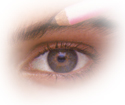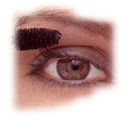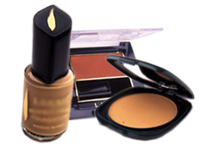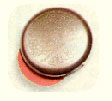 Cleanliness and hygiene should be followed when using eye cosmetics or it can lead to some infections of the eyes. It is not good to borrow or lend any eye make up and it is best to always keep your hands clean while using eye make up.
Cleanliness and hygiene should be followed when using eye cosmetics or it can lead to some infections of the eyes. It is not good to borrow or lend any eye make up and it is best to always keep your hands clean while using eye make up.
Eye Shadows
Eye shadows leave a shiny or opaque finish depending on the time of make up and shape of eyes. To achieve the perfect daytime look with eye shadow, you need to follow some basic guidelines. The basic tones you need are
(a) a pale highlighter shade for your brow bone area.
(b) a basic shade for your eyelids.
The shades you choose can be deep-toned or pale, neutral or bright, but they should be applied so that they are not too strong. Blending is important while applying eye shadow. The colour used should be appropriate to the colour of the skin and match the colour of the dress. When you use more than one shade they should be so well blended that you can't tell where one ends and the next one begins.
Forms of shadows:
Eye Shadows come in a variety of forms like pressed powders, pencils, sticks, gels or creams. Pressed powders are the most popular form of shadows. They are available in pearly and matt textures. You can get a better effect, if you apply them with a wet brush. The cream shadows are oil or wax based. It is best suited for dry lids and should be avoided on greasy eye lids. Pencils have a high colour and filling ability. Gels are suited for oily skins.
Brushes for application:
A straight - bristled brush for each colour and a round bristled brush for blending.
Application:
When you apply eye shadow, always start with the highlighter shade. Brush it just under the outer end of each eyebrow and quickly blend the colour inward toward the inner end of the eyebrow, above the inner corner of the eye. After that apply the eyelid shadow by beginning in the centre of each lid, just above the pupil of your eye. With a blending brush, make a quick back and forth motion. Finish the make up by blending upward to meet the highlighter shade.
Eye liner
Eye liners are the most extensively used form of eye make up. Eye liner is used to make the eyes more prominent and create an illusion of thicker lashes. Eye lining is done with a black or brown eye liner on the top lid of each eye and sometimes under the lower lashes. The line should be smooth instead of a harsh line.
Forms of liners:
Eye liner comes in liquids or pencil form. Care should be taken when using liquid eye liner. It should not go into the eyes. Liquid liners can be either water based or alcohol based. Alcohol based liners are water proof.
Application:
To apply liquid eye liner, draw the brush out of the bottle or tube and stroke it against the mouth of the tube to remove excess liquid and taper the brush to a fine point. Using the very tip of the brush, stroke the eyeliner evenly across the lid as close to the base of the lashes as possible, beginning with the inner corner of the eye and continuing to the outer corner of the eyelid. Apply the line in several short brush strokes.
Indians have our own indigenous type of eye make up -kajal. Home made Kajals does not contain any chemicals.
Eye defining pencil
Eye defining pencil adds definition and a hint of colour to the bottom of each eye. It is available in variety of colours. The pencil should have a fine point and a medium to soft lead so it glides on easily under the lower eyelashes. 
To apply eye defining pencil, lightly stroke a single, fine line under the lower lashes starting at the outer corner of the eye. The line must be close to the base. Run the pencil smoothly under the lashes along each lower eyelid to the inner corner of the eye. Then use an angles brush or a cotton swab to soften and blend the line. Eye defining should be never be a hard, thick line.
Eye brow Pencil
An eyebrow pencil emphasizes the eye brows, improves their shapes and makes them look thick. The colour of the eyebrow pencil should never be darker than that of your brows or hair colour. 
To apply eyebrow pencil, brush your eyebrows with a eyebrow brush to remove excess foundation or face powder. Then with outward brush strokes, smooth the hairs in the direction in which they grow. To shape your brows properly, begin by using short, light strokes of the pencil to outline the top of each eyebrow up to its arch. Use featherlike strokes to extend each brow to the end. Fill in any sparse areas by using these same strokes. Then brush your brows with an eyebrow brush to smooth them and blend in the pencil strokes.
Mascara
Mascara thickens the eye lashes and increase attractiveness of the eyes and emphasize them. It gives the eye make up the finishing touch. Brush the lashes, apart from application. Light coats are better than thick ones.
Forms of Mascara:
There are 3 different forms of Mascara - water based, water proof and the mixed variety. Mixed variety is the the most useful one. Water based mascaras can be applied quickly and removed easily. So they are gentle to the lashes and eyes. But they won't stay for a long time, as the mascara smudges easily when it comes into contact with water, tears and perspiration.
Water proof variety stay for a long time and is water proof and smudge proof. They are a good investment as they are resistant to contamination and can be used even years after they have been manufactured. But it takes a long time to dry and is difficult to remove the liner. The mixed variety is a combination of water based and water proof mascaras. These dry quickly and is easy to remove.
Application:
Apply mascara by looking straight into the mirror, with your chin lifted slightly so you can see your lashes clearly. Gently twist the spiral brush as you withdraw it from the masara bottle. Stroke your upper lashes evenly from their base to the tips, curling them upward with the brush as you apply the mascara. Apply mascara to the lower lashes with downward strokes, wiggling the brush back and forth a bit to separate the lashes. After you have applied the mascara to both eyes, you can repeat the application to add more fullness to your eyelashes.
Under eye concealers: They are intended to hide blemishes and dark circles under the eyes. Application of make up above them, does not remove them.
 cakes (pancakes). This can be chosen depending on how much clarity or cover you prefer.
cakes (pancakes). This can be chosen depending on how much clarity or cover you prefer.
